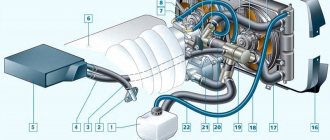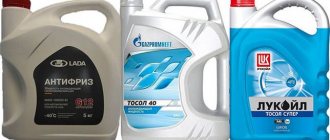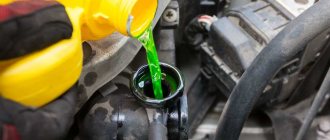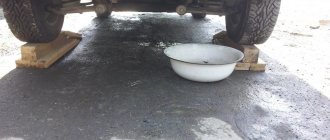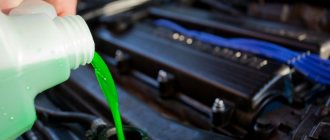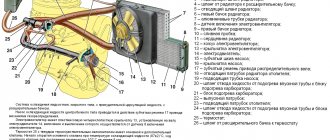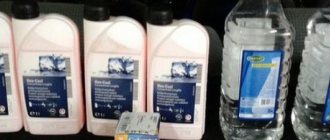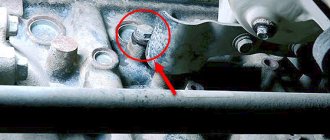Print this article Font size 16
It is far from a fact that when buying a used car you will be able to find out literally everything about the car you are purchasing. For example, do you know what kind of coolant is used? Some people use antifreeze, others prefer antifreeze. Although there are some unique car owners who use ordinary water.
When buying a car secondhand, be sure to check the presence and quality of coolant in the engine system.
Coolant in a car
Answers (2)
The VAZ 2114 cooling system can be filled with both antifreeze and antifreeze.
However, antifreeze is better - it lasts longer and is gentler on the car's components. And the difference in price is small. It is recommended to use red antifreeze, for example FELIX carbox 40 G 12, but others are also possible.
The volume of liquid is about 7.5 liters. Replacement interval is every 5 years. In fact, when replacing, less than 7 liters can be filled.
If you have filled with antifreeze and want to switch to antifreeze, then before filling, you need to get rid of the old fluid.
How to drain antifreeze? There is nothing complicated about this. To do this, you need to unscrew the radiator drain plug - the heater tap, and drain the liquid.
Next, you need to drain the coolant from the engine - there is a plug there, you can see it in the photo - unscrew it and drain it.
Then fill in new coolant to the level in the expansion tank.
PS If you need to add fluid to the system, then fill only what has already been filled. If the coolant is red, then only that color; if it is green or blue, then only that color. Antifreeze should not be poured into Tosol.
Radiator tap or cap
Unscrew the plug in the engine and drain the fluid
It is impossible to talk about which antifreeze is most suitable for the VAZ 2114 without talking about the liquid poured in at the factory.
Filling volumes and brands of oils and liquids Lada VAZ 2114
| Filling/lubrication point | Filling volume, liters | Name of oil/liquid |
| Fuel tank | 42,5 | Motor gasoline AI-91, AI-93, AI-95 |
| Engine cooling system including interior heating system | 7,8 | Coolant “Tosol AM”, “Tosol A-40M”, “OZhK LENA”, “LENA-40”, “SPECTROL ANTI-FREEZE”, “AGIP ANTIFREEZE EXTRA”, “Glisantin G 03”. |
| Engine lubrication system including oil filter | 3,5 | Motor oils "LUKOIL ARCTIC" (5W-40, 5W-30; SG/CD); “YAR-MARKA SUPER” (5W-40, 5W-30; SG/CD); "ESSO ULTRA" (10W-40; SJ/SH/CD); "ESSO UNIFLO" (15W-40; SJ/SH/CD). |
| Gearbox housing | 3,3 | Transmission oils (classification according to SAE; API) “REXOL T” (80W-85; GL-4); "VOLNEZ TM-5-12" (80W-85) |
| Hydraulic brake system | 0,435 | Brake fluid "ROSA"; "ROSA-3"; "ROSA-DOT-4"; "SPECTROL DISK BRAKE FLUID" DOT-4; "AGIP BRAKE FLUID" DOT-4; "HYDRAULAN 408" DOT-4 |
| Hydraulic front suspension strut | 0,31 | Liquid for shock absorbers GRZh-12 |
| Rear suspension shock absorber | 0,25 | |
| Windshield and headlight washer reservoir | 4,2 | A mixture of water with special liquid “OBZOR”, “GLASSOL” or “Window washer fluid “ASPECT” |
| Starter drive drive ring Steering rod joints | Grease “Litol-24”, “AGIP GREASE 30”, “ESSO UNIREX No. 2”, “ESSO UNIREX No. 3”, “EXXON MEHRZWECKFETT” | |
| Front wheel drive hinges Door opening limiters | Lubricant “CV joint-4M”, “SPECTROL CV joint MoS2” Lubricant “CV joint-4” | |
| Steering gear housing Door, hood and trunk locks | Lubricant "FIOL-1" | |
| Front suspension ball joints | ShRB-4 grease | |
| Battery terminals and clamps Trunk lid torsion bars Door and trunk lid keyholes Fuel filler flap hinge and spring | VTV-1 auto lubricant in aerosol packaging | |
| Pressure regulator | Grease DT-1, Ditor |
What and how much to fill in LADA (VAZ) 2114 Samara
Fuel system
Fuel tank - 42.5 l. Fuel type: gasoline AI-92, AI-95.
Engine lubrication system
The engine oil is changed every 10 thousand km. The permissible deviation is 1 - 2 thousand km. The oil filter must be changed at this mileage. The recommended fluids for VAZ 2114 power plants are:
- LUKOIL ARCTIC (5W-40, 5W-30; SG/CD);
- “YAR-MARKA SUPER” (5W-40, 5W-30; SG/CD);
- "ESSO ULTRA" (10W-40; SJ/SH/CD);
They are also used for the engine crankcase.
Engine cooling system
Antifreeze must be changed every 60 thousand km or once every two years. The following coolants are recommended: “Tosol AM”, “Tosol A-40M”, “OZhK LENA”, “LENA-40”, “SPECTROL ANTI-FREEZE”, “AGIP ANTIFREEZE EXTRA”, “Glisantin G 03”. Refill volume – 7.8 l.
Transmission
The car's operating instructions indicate the frequency of changing transmission oil - 30 thousand km. Suitable lubricants include:
The lubrication of the rear axle housing is changed every 60 thousand km. At the same time, its level is periodically monitored - every 20 thousand km. If necessary, top up to the mark.
Brake system
Brake fluid should be replaced once every two years regardless of the vehicle's mileage. Domestic DOT-4 or a foreign equivalent is recommended. For example, "ROSA"; "ROSA-3"; "ROSA-DOT-4"; "SPECTROL DISK BRAKE FLUID" DOT-4; "AGIP BRAKE FLUID" DOT-4; "HYDRAULAN 408" . Volume – 0.435 l.
Content
How can I find out what kind of coolant was filled in at the factory?
In the vast majority of cases, it is very easy to find out the brand of antifreeze that was initially poured - just look at the sticker placed on the tank. This sticker always indicates in large letters the liquid with which the system was filled (and which it is recommended to add as needed).
In the vast majority of VAZ 2114 cars, the liquid filled at the factory is either Felix TC-40, produced in Dzerzhinsk, or CoolStream Standart 40, produced in Klimovsk. They can also be distinguished by color.
The first is bright green, the second is either green-yellow or faint green, in both cases there is slight fluorescence. Both of these liquids are antifreeze (belonging to class G11), and they can only be mixed with other liquids from this class.
Many people believe that Antifreeze is much worse in quality than antifreeze, so they cannot be mixed. This is incorrect - the reason lies not in the quality or acidity of the medium, but in the very different densities of these two liquids.
If it is not intended to replace the coolant with a liquid of a different category (for example, antifreeze for antifreeze), then you can add it without draining the entire cooling system. Otherwise, this operation will be strictly necessary.
How the cooling system works
To ensure timely cooling of the engine, an entire system consisting of several elements has been created. It includes:
- expansion tank, the main function of which is to store liquid in it;
- tank plug, necessary to normalize the pressure inside the system;
- radiator - the main cooling element that removes heat to the external environment;
- electric fan for cooling antifreeze;
- pipes through which coolant moves;
- thermostat - an element that controls the movement of antifreeze through the system;
- a pump that serves to pump coolant;
- the engine jacket through which antifreeze circulates.
The entire operation of the system depends on the serviceability of each element.
Antifreeze is intended for pouring specifically into VAZ cars
Antifreeze or antifreeze - what to choose
Before you find out what antifreeze to pour into the VAZ 2114, you should figure out how, exactly, antifreeze differs from antifreeze? And why can’t they be poured into one system at the same time?
To put it quite simply, dividing coolants into antifreeze and antifreeze is not entirely correct. After all, antifreeze is also one of the varieties of the latter. The point here is that classic antifreeze was developed specifically for VAZ cars and, despite the composition being very close to modern antifreezes, it has a different density.
The presence in the cooling system of two solutions with different specific gravity (antifreeze and antifreeze) can lead to foaming and disruption of coolant circulation.
It is also worth noting that classic antifreeze (its category is marked with the symbols Tl) has a slightly more aggressive chemical environment, which can sometimes even lead to damage to the radiator (of course, with very long-term use of the car). In addition, an important difference between it and antifreeze is that the liquid sold in canisters is a semi-finished product.
It's not just the engine that needs to be cooled...
The car's engine cooling system, as its name suggests, is designed to cool the power unit, since its operation is accompanied by a large amount of heat. Without proper cooling, the motor will not last long - its mechanical parts will jam due to overheating, and all the electronics will simply burn out.
In addition to its main function, it is actively involved in a number of processes occurring in the car. For example, it is a source of heat for heating the interior and air conditioning, reduces the temperature of oil, exhaust gases, transmission fluid, and also cools the air for the charging system if the engine is equipped with a turbine.
In a word, the cooling system is an indispensable link in the chain of components and assemblies that ensure reliable and, most importantly, durable operation of the engine.
What categories of coolant can be mixed
Of course, the best option would be to fill the system only with liquids from one category, but if for some reason this is not possible, then you should use the following compatibility table:
- Antifreeze Tl - only with antifreeze Tl.
- G11 can be mixed with G13, G12+ and G12++.
- G11 must not be added to G12.
- G12 can be mixed with G12+, G++, G13.
- G13 cannot be mixed with G12, but with other types it can.
Being guided solely by the color of the coolant when purchasing/refilling/replacing it is fundamentally wrong. Some manufacturers paint antifreeze and antifreeze in colors different from the generally accepted ones. The color has no effect on the chemical composition and density of the liquid.
Flushing
Many experts agree that the system should be flushed before replacing the coolant. But how to do this and is such an event really mandatory?
If the coolant being drained shows signs of rust and contamination, then the system should still be flushed. This preventive measure will never be superfluous. Therefore, try to allocate some of your precious time to the procedure. The engine will remain grateful to you.
The cooling system is washed quite easily:
- Drain the old fluid by unscrewing the drain plug;
- Fill the system with water through the filler neck;
- Distilled or boiled water can be used as a washing composition. Plus, there are special cleaning compounds. They are more expensive, but their efficiency is higher;
- Start the engine with flushing water inside and let it idle for about 30 minutes;
- Drain;
- If it is very dirty, repeat the procedure;
- Add new coolant to the system.
Fluid replacement
If you plan to switch the car from antifreeze to antifreeze for any reason, then the old coolant should be drained by unscrewing the plugs in the block and in the radiator. It is worth remembering that this will not help remove the entire volume of coolant (and it is consistently equal to 7.8 liters).
In order to completely clean the entire system, you should fill it with ordinary water and drive the car for about 30 kilometers, after which you should drain everything again and add antifreeze. It goes without saying that this procedure can only be carried out in the warm season, but not in the cold.
It should be said right away that some motorists perform themselves and advise others to carry out additional procedures for cleaning the system of old coolant - adding vinegar, acetone and other additives to distilled water. It is strictly not recommended to carry out such operations. At best, they will be of no use; at worst, they can cause damage to the cooling system.
Common malfunctions in the VAZ-2110 cooling system
Auto repair specialists identify the following main malfunctions that affect the cooling system:
- leakage of antifreeze and its deficiency;
- due to a malfunction of the pump pump, there is no pressure;
- the cooling fan does not function correctly or does not turn on at all, this is due to errors in the operation of the temperature sensor;
- the thermostat is inoperative, which prevents the circulation of the solution through the large cooling circuit;
- contamination of the plates installed in the radiator.
Monitor the condition of the machine and immediately respond to the appearance of extraneous sounds when the pump pump is turned on.
Experts advise monitoring the level of coolant in the tank and replacing the old one with a new one every 75,000 km of the VAZ-2110.
We recommend: How important are tire storage conditions for operation?
To determine whether there are any temperature errors, periodically refer to do-it-yourself methods for diagnosing the cooling system. The radiator, which is responsible for cooling, requires regular cleaning and temperature control when the engine is running.
Which coolant to choose
Every motorist who wants to replace the entire coolant in the car system is interested in what kind of antifreeze to pour into the VAZ 2114? And which one is better not to buy? First of all, it’s worth saying that there are now a very large number of counterfeit coolants on the market, which can be easily recognized by poor-quality packaging and labels. In addition, you should always carefully read the name, which should indicate the category of the liquid.
As for brands and manufacturers, preference should be given to the following:
- CoolStream Standard – G11, green;
- CoolStream Premium – G12, orange;
- Lada Concentrate - category G11, produced either by Oil Center (Tolyatti) or Bulgar Lada Plus (Kazan);
- Lada A-40 - similar to Lada Concentrate, but supplied ready-to-use;
- OZH-65 TOSOL-TS - classic antifreeze, produced in the city of Dzerzhinsk;
- OZH-65 TOSOL-TORSA – G11, blue-green color;
- “Antifreeze G-48” – slightly green, G11. Previously produced in Perm, now rare.
When is it necessary to change the cooler?
Replacing antifreeze in a VAZ 2114 is based on several points. In the vehicle maintenance instructions, the manufacturer indicates that antifreeze must be replaced after 75,000 km, that is, approximately once every three years. But, there are cases when replacing antifreeze in a VAZ 2114 should occur earlier:
- premature corrosion. This can be seen when the substance turns gray-brown in color. Replacement must be made immediately;
- the formation of a jelly-like mass on the inside of the neck at slightly low temperatures. Replacement should occur as soon as possible after such a process is noticed.
To summarize, it can be noted that the service life of antifreeze directly depends on the quality of the coolant and the amount of mileage.
Actual tank volume on the 14th model
As mentioned, the manufacturer claims that the volume of the 2114 tank is 43 liters (in some cases you can find a figure of 42.5 liters).
And this figure is indeed very close to reality. At the same time, it is worth considering a number of facts that can significantly affect capacity:
- Errors in the manufacture of the tank.
- Time of year and temperature.
- Fuel system volume.
The first of these factors is usually insignificant. But, as practice shows, sometimes the difference in the volumes of two identical tanks can reach (as a result of low production accuracy) 2 liters. Thus, on some machines the total volume can reach 45 liters (which is extremely rare).
This should also include the difference in weather conditions. In cold weather, the fuel contracts, and in warm weather, it expands. This factor also affects how many liters the tank on a VAZ 2114 can hold (if we take into account the full volume of gasoline that can fit in hot summers and winter frosts, the difference can reach 1.5 liters).
Well, finally, you should remember that the fuel system itself also holds a certain amount of fuel. On average, when the tank is completely empty, up to 2 liters of gasoline can remain in it. As a result of this number of features, the amount of fuel contained in the tank may differ from that declared by the manufacturer, either more or less.
It is also worth noting that if the vehicle is operated incorrectly and refueled with low-quality fuel, sediment can accumulate at the bottom of the tank, which over time can (albeit insignificantly) reduce its volume. In order to avoid such a situation, the tank should be inspected every few years.
Specifications
Let's look at each element of this car separately and talk about its characteristics.
Body
The body of the 2114 is a hatchback and has remained virtually unchanged since 2003, only the equipment and various linings such as moldings and a spoiler have changed. In 2007, the body was restyled in which the car began to look prettier.
dimensions
Engine
The engine on the 2114 was installed in two capacities: 79 and 81 hp. there were also SuperAuto configurations with a 16-valve engine. The table below shows the technical characteristics of the engines installed on the 14th.
| Years of manufacture | 2003-2007 | 2007-2013 | |
| Engine | 2111 | 1183 | 21126 |
| Type | Petrol | Petrol | Petrol |
| Volume, l/cub. cm | 1,5/1498 | 1,6/1596 | 1,6/1596 |
| Power | 79 | 81 | 98 |
| Number of valves | 8 | 8 | 16 |
| Gas pedal drive | Cable | Cable, E-gas | E-gas |
| Fuel | AI - 92 | AI - 95 | AI - 95 |
| Number of cylinders | 4 | 4 | 4 |
| Number of valves per cylinder | 2 | 2 | 4 |
| Torque | 3800 | 3800 | 4200 |
| Supply system | Distributed injection | Distributed injection | Distributed injection |
| Fuel consumption, l. | 7,2 | 7,0 | 7,2 |
| Maximum speed, km/h | 160 | 170 | 183 |
| Engine location | Transversely, in front | Transversely, in front | Transversely, in front |
Gear box
The gearbox was inherited from the younger model and has five gear levels. A fairly reliable and unpretentious gearbox, the main “diseases” of which are the rapid failure of synchronizers and the crunch of second gear.

